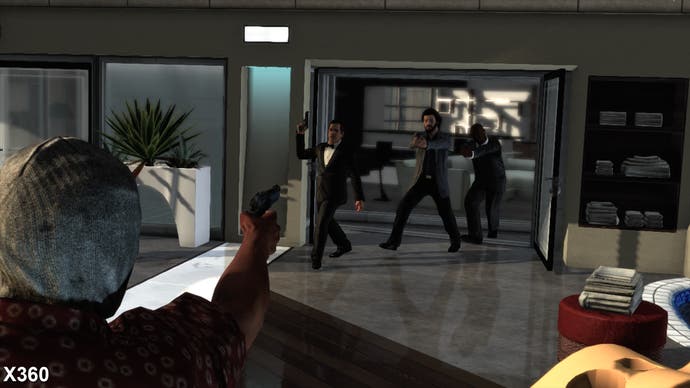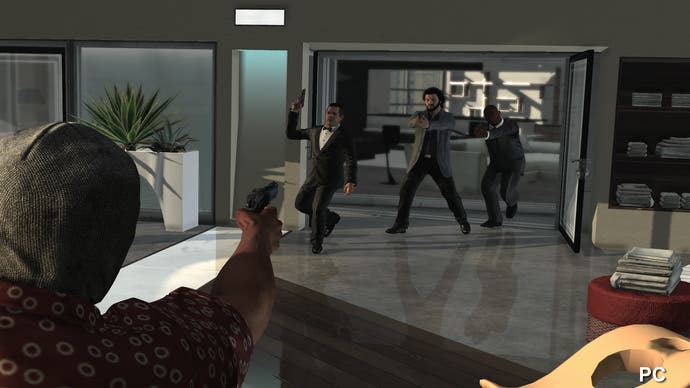Tech Comparison: Max Payne 3 PC
Max settings.
Released a couple of weeks after the console versions to avoid being crushed by the Diablo 3 juggernaut, Max Payne 3 on PC is no mere afterthought or lazy port. Put simply, it's by far and away the best version money can buy, embossed and embellished to a standard that should satisfy the majority of the PC userbase.
The secret of its success is simple: Rockstar has realised that enthusiast PC gamers typically run gameplay at high resolutions, and at 1080p and beyond, console-quality artwork simply doesn't cut the mustard.
This would also explain the frankly monstrous 29GB Steam download we had to endure last Friday once the game finally unlocked.
"The installed size of Max Payne 3 is attributed to the no-compromise quality of its assets which have already pushed console disc space to the limits," the publisher says.
"A good portion of the extra space on PC can be attributed to increased texture size which is four times that of the consoles. In addition, the audio quality is significantly higher than the consoles due to lower compression rates which increase fidelity. Again, this comes back to the range of possibilities that the PC platform opens up for us."
Before we begin, let's put this into perspective a little. Run the PC game next to console versions at 720p, and you may wonder whether that 29GB download is justified. Yes, the artwork is obviously more clearly defined, frame-rate is much smoother, and the blur invoked by cheap console post-processing anti-aliasing is gone, giving a far more pristine look to the game, but there isn't a Battlefield 3-style night-and-day difference. Below you'll see the Xbox 360 game up against PC, and we've also prepared a PS3 vs. PC video too.
The key word here is refinement. The basic FXAA anti-aliasing technology found in the console versions is replaced with the more advanced PC equivalent (with several quality settings) along with the option for 2x, 4x and 8x multi-sampling anti-aliasing.
The good news is that the FXAA options generally provide decent results, which is just as well because the bad news is that MSAA incurs a pretty horrific hit on performance. The video above, running at 50 per cent speed, is clearly smoother than the console equivalent, but the fact is that even at 4x MSAA, a Core i7 PC running at 3.33GHz in combination with the GeForce 680GTX couldn't sustain a locked, v-synced 720p60. Gameplay is no problem, but cut-scenes see noticeable judder caused by dropped frames. Also curious is that the actual anti-aliasing coverage seems to be fairly patchy, and "jaggies" are often noticeable - something you probably spotted in the video above.
The solution is fairly straightforward: rely on the PC's superior implementation of FXAA, bin off the MSAA and suddenly you'll discover that Max Payne 3 is actually a bit of a performance winner: with every other setting at the highest level and resolution locked to 1080p, high-end GPUs should be hitting in excess of 100FPS. To get some idea of the hit MSAA incurs, NVIDIA's stats on the extent of the impact to performance are quite remarkable. Clearly, removing it completely is the way forward for the smoothest frame-rates.
Once this has been sorted, the figures strongly suggest that ultra high-end PC users - including tri-screen "surround" and NVIDIA 3D Vision devotees - should encounter few problems enjoying a rich, smooth, 1080p experience even without shelling out for an expensive SLI multi-GPU set-up. Scale back on other processor-intensive features and even more modest PC gaming set-ups should still be able to produce a console-beating experience - even a fast Core i3 processor with an enthusiasts' favourite like the Radeon HD 6870 should do the job quite nicely (yes, the dual-core nightmare of GTA4 are a thing of the past). While there is a law of diminishing returns on the visual boost offered by the top-end quality settings, PC gamers who've invested in their kit should be quite happy with the additional bling on offer.
"The performance nightmare we saw with the RAGE engine on GTA4 is a thing of the past - Max Payne 3 runs well on modern dual-core CPUs and is impressively scaleable across the board."




Rockstar has certainly pulled out the stops on the additional rendering features. The screen space ambient occlusion (SSAO) found in the console versions has been improved significantly and if that isn't good enough, a higher fidelity HDAO (high-definition ambient occlusion) feature has been added. Shadows, reflections, water and shader effects have also been given higher-precision upgrades and selectable texture processing offers up to 16x anisotropic filtering. DirectX 11 features have been implemented that not just offer some of the more refined effects but also draw upon the improvements Microsoft has made to parallelism in the API to offer a useful performance boost.
Another DX11 feature implemented is tessellation - which procedurally increases poly count for smoother edges. In the case of Max Payne 3, only the characters and the vehicles have been upgraded and it's safe to say that the effect is fairly subtle overall, but regardless, the addition is obviously welcome. We suspect that this technology will only really come to the fore on all elements of artwork design once the next-gen consoles support it, hence the limited support we've tended to see thus far.
In short, this version of Max Payne 3 works because the rigid 720p focus we see on the vast majority of cross-platform games ported to PC isn't anywhere near as much of an issue here. Rockstar has recognised the shortcomings of low-detail textures rendered at high resolution and terrible-quality 720p FMVs upscaled to 1080p, and, to its credit, the publisher has gone the extra mile in making sure that the PC experience doesn't feature these compromises.
Rockstar's decision to go for the 29GB download was the right one: art remains crisp, vibrant and rich in detail at high resolutions. Meanwhile, the cinematics are an immense improvement over the console versions: they're encoded at full 1080p and given a decent amount of bandwidth to shine. The only disappointments here are a 30FPS frame-rate (at odds with the 60FPS enthusiasts will be aiming for in their gameplay, making the FMVs stick out somewhat) and the fact that - curiously - the base visuals seem to lack anti-aliasing.
To give you some small idea of the overall improvement the PC version represents, we have an interesting comparison. We captured the first level of Max Payne 3 with the Xbox 360 set to 1080p on the dashboard, with the GPU scaling up from the game's native 720p. Then we repeated the process on PC at very high settings with Max Payne 3 running at 1080p. For more comparisons, we've prepared an Xbox 360 vs. PC full HD gallery if you want to see more.
"Rendering refinements aside it is the visual scaleability of Max Payne 3 that is most impressive - it's a game that looks bright, vibrant and rich in detail at 1080p resolution."




"We had always stated that our goal with Max Payne 3 on PC was to have a game that runs beautifully out of the box on day one across a wide range of machines. To achieve this goal we developed the PC version in parallel with the consoles instead of a direct port," says Rockstar.
"The PC is the only platform where you can really max out the high end if you want to, and we wanted Max Payne 3 on PC to have the potential to look beautiful on the highest possible resolutions on the biggest monitors available - so while we can still scale performance down to suit even reasonably low-end rigs, every asset is available at the highest resolution possible, from audio to video to textures."
It's difficult to argue with Rockstar's sentiments. This is clearly the best edition of the game available and the publisher deserves kudos if only for the boost to the core artwork alone, acknowledging that enthusiast PC owners left low resolutions behind years ago.
However, as welcome as the improvements are, it's important to put the final game into context. There isn't the revelatory leap in the quality of the overall experience that we see when we compare titles like Battlefield 3 or Crysis 2 at max settings up against their console equivalents. Max Payne 3 is clearly a game of the current-gen console era, built using an engine primarily created with the Xbox 360 and PS3 in mind. Its enhancements are more about boosting existing effects, improving artwork and making the experience work at 1080p and beyond. In that respect, it's a great success.









